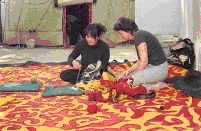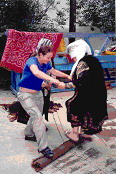Kochkor village, Kyrgyzstan
The town is actually a conjoining of two villages. One guide book calls if a "sleepy little Kyrgyz village" - although it is a little hard to imagine it as "sleepy" when you consider the number of people in the main square almost every day. Another travel writer was reminded of the paintings in Bishkek's Fine Arts Museum of traditional Kyrgyz life, enhanced by enlightened Soviet settlement policies. This probably has something to do with things like the metal cutouts on the lampposts along the length of the main street - a hammer and sickle; a rocket blasting into space and a sculpture of an atom representing science; a cog wheel representing industry and technology; corn representing the agriculture of the region … and so on. There are also painted wooden fences with slats of wood held together by an elongated diamond shape - typical of villages everywhere in the former Soviet Union.
Actually, the history of Kochkor does represent this in some ways. It is supposedly the site of the first settlement in the valley. There are some ancient barrows to the to South - between Kara Suu and Bolshevik. Situated on the main road from Balykchi to Naryn, at a point where the road to Suusamyr (and on to Osh forks off from the main road to China from Issyk-Kul and the Chui valley) it marked a natural stopping point for a camp for nomads and travelers.
A mosque and an inn (Chayhana) were established. As such it has always attracted a wide variety of nationalities. As well as the Kyrgyz - Uzbeks, Uighers, Dungans and later Russian and German settlers were attracted to the plain. (Since independence, many of the other nationalities have, in fact, left.)
In 1909 the spot was renamed Stolypin, after the Russian Prime Minister who was a major advocate and proponent of Russian expansion into, and the settlement (colonization) of Central Asia. Stolypin and the Bolsheviks, under Lenin, were violently opposed to each other's ideas and after the 1917 revolution, the town was renamed Kochkorka - and as with many towns which have been renamed since independence - the Kyrgyz version of the name Kochkor was adopted.
The region has a mild climate and the land between the mountain ridges is ideal for agriculture. In Soviet times there were several large collective farms in the valley and Kochkor was well known for its crops - especially potatoes, which are still sought after.
As well as just "soaking up the atmosphere", (for example by walking along the main street that runs though the town; spending some time in the main square; perhaps visiting the market and visiting the cemetery with it's eclectic collection of memorials - a visit to the Regional Museum could prove interesting. There are said to be over 5,000 exhibits in its nine rooms. A fine yurt is on display, along with a collection of traditional Kyrgyz crafts and exhibits on local "soviet heroes". In the club of the Sonkul sovhoz there is a mosaic by the famous artist Theodore Hertzen. If you have time and are interested, there are a couple of enterprises here which manufacture and sell traditional Kyrgyz crafts - and are likely to be cheaper than in Bishkek shops. (Don"t be surprised if you see shyrdaks hanging out over the fence - or lying in the road … it is possible the shyrdaks are for sale … but it more likely to be a family "spring cleaning").
Because of its position on the main road from Bishkek/Issyk Kul to Naryn (and hence onto China) and from Issyk Kul to Osh and the South, Kochkor offers a fine base from which to make trips into the surrounding countryside.
Traveling from Bishkek/Issyk Kul you pass the Orto Tokoy reservoir. The water level fluctuates considerably throughout the year, but the turquoise color can be quite striking - and in winter, when it is frozen over it has a mystical, desolateness. Incidentally, the reservoir is on the same River Chu that flows down to Bishkek via Boom Gorge … although you might get the impression that it must flow via Issyk Kul - it doesn't … it swings around the end of the Kyrgyz Ala-Too range. From Kochkor it is possible to visit Son Kul, either by driving up towards Naryn as far as Sary Bulak and then turning off … or by taking the Osh Road and turning off to Kara Keche before Chaek. There are several mountain pastures (Jailoo) in the region and it possible to trek, ride horses, or drive to several of them and overnight in a yurt with a shepherd's family.
As well as sheep, you will see many horses. The Kyrgyz pride themselves on their horsemanship … it is often said that Kyrgyz boys learn to ride before they can walk. The horses are valuable animals - and provide the Kyrgyz with meat and Kumyz as well as a mode of transport. However, any animal that is going to be slaughtered for meat will never be ridden - as it affects the quality of the meat.
About 25km from Kochkor is the Chong Tus complex. Here is a mountain of rock salt, and in Soviet times a mine was established to extract the mineral. The mine still operates and salt is produced not just for use in Kyrgyzstan - but is also exported. You won't find it on your table, however, as the rock salt is usually given to farm animals as a food supplement. Also, during the Soviet period many people would come here for treatment for Asthma and allergies. Apparently, spending time in the atmosphere inside the salt mine is thought to be very beneficial. A course of treatment involves staying in the mine for 10 hours a day for 16 days. In recent years a development program has been underway to turn the mine into a health resort including accommodation and facilities. Travelers, assuming that it isn't full of patients at the time, can also use the center. They have their own jailoo, about a three hours trek away, above the center.
 There are two roads to Suusamir from Kochkor. The Southern route passes through a number of villages - the largest is Chaek. A detour off this road to Min Kush is possible. The Northern route follows a river gorge - but is virtually deserted as no one lives there. The road conditions can be very poor.
There are two roads to Suusamir from Kochkor. The Southern route passes through a number of villages - the largest is Chaek. A detour off this road to Min Kush is possible. The Northern route follows a river gorge - but is virtually deserted as no one lives there. The road conditions can be very poor.
To the North of Kochkor, there used to be a road over the Kyrgyz Ala-Too mountain range to the Kegety Gorge, and down to the Chui valley. It is featured in one travel book as a spectacular route for mountain biking - but it is not possible to travel along it by car now, not even in an off-road 4WD vehicle (we've tried it!), because of landslides and avalanches. Also, it is closed by snow until well into the summer.
The "Shepherd's Life" project is a local initiative inspired by the Swiss development program "Helvetas". A network of nomadic families offers homestays and can organize transportation and other services (horse riding, trekking, guides, talks and demonstrations of local crafts, concerts of traditional Kyrgyz music) in the region. Homestays and farmstays are popular all over the world - and for those who are willing to spend the time getting acquainted with the host families and their way of life - it can be a most rewarding experience (as well as offering the shepherds and farmers a way to supplement their income). The program has been very successful - it has been featured in travel guides; it has it's own web site; it has been extended, not only to other parts of the Naryn region - but has been copied in other parts of Kyrgyzstan as well.
Legends of Kochkor
As is often the case, there are a number of legends associated with how the village of Kochkor got its name. Perhaps the most romantic tells of a poor, well educated young man - a traveler. On one of his journeys he stopped at the camp of the local Khan. The Khan had a daughter who was very beautiful - and many of the local prices had already tried to woo her - all of them unsuccessfully. In short, the traveler met her and fell in love - asking the father to allow her to marry him. Although the Khan laughed at the poor traveler, he was not amused and decided to teach him a lesson. He decided to set the would be son-in-law an impossible task. He offered the young man a chance to breed camels for 10 years and if in that time his stock increased by a hundredfold, then he could marry the princess. The young man was so in love with the girl that he set about his task. The first winter was unusually harsh.
 One day there was an eclipse of the sun and a chill fell across the face of the earth and a storm blew in. The wind was so strong that the man could not even open his eyes. Exhausted, using the last of his strength, the young man cried allowed "Kach kar, Kach kar!" (which roughly translates as "Go away snow, Go away snow!") Nature heard his cry and took pity on him - the storm abated, the wind died down and the snow stopped falling. From that day, so the legend has it - it rarely ever snows in Kochkor.
One day there was an eclipse of the sun and a chill fell across the face of the earth and a storm blew in. The wind was so strong that the man could not even open his eyes. Exhausted, using the last of his strength, the young man cried allowed "Kach kar, Kach kar!" (which roughly translates as "Go away snow, Go away snow!") Nature heard his cry and took pity on him - the storm abated, the wind died down and the snow stopped falling. From that day, so the legend has it - it rarely ever snows in Kochkor.
Incidentally, the young man was successful: he prospered and his herd of camels increased by the required amount and so he eventually married his princess. They had a son who became a great warrior.
Another legend tells of an old widow, who was very poor, who sent a sheep to market. She couldn"t go herself - so she entrusted it to a couple of her friends. The sheep was already very skinny and looked very sickly and the friends did not look after it very well on the journey. As a result, when they arrived at the market, no one wanted to buy the animal. There was an organized "sheep-fight" and the men decided to enter the animal. Because it was thin it was able to fun around a lot more than its rivals around which it literally ran rings … until the opponent dropped from fatique. Having done so well, it was entered for another, bout … and another. As well as earning a lot of prize money - and from bets, it became famous and the village was named in it's honor - Kochkor.
